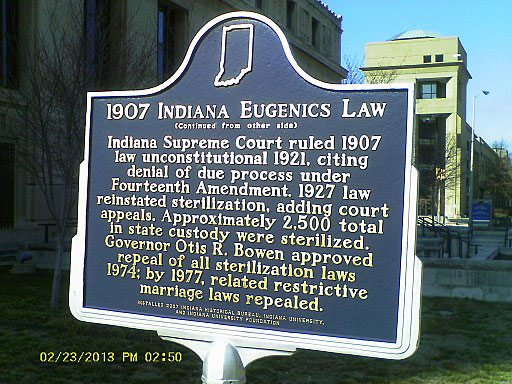
July 21, 2017; Washington Post
A recent standing order issued by General Sessions Judge Sam Benningfield allows the prisoners incarcerated in White County, Tennessee, to gain 30 days’ credit toward their jail time if they “volunteer” to be sterilized. Reports about the action come even as a memorial was established on Malaga Island in Maine to commemorate the 40 or so mixed-race residents of that island who were “removed” from the island in 1912. Some of the residents were sent to the then-new Maine School for the Feebleminded. Even the graves on the island were dug up, and the contents dumped into five caskets, which were buried on the grounds of the school, now called Pineland.
So, what connects these two stories? Bill Schambra has explained many times in his treatises about eugenics (in particular, in his 2012 article in Nonprofit Quarterly, “Philanthropy’s War on Community”) that the eugenics movement was supported generously by some of the “fathers” of philanthropy, Carnegie and Rockefeller among them, and that its legacy is still with us in certain philanthropic and public practices. Rick Cohen wrote about this in his article linking eugenics and the practice of real estate “redlining”:
The Rockefeller Foundation funded German research institutions in the 1930s, some employing well known and future Nazis such as Ernst Rüdin and Josef Mengele, while the Carnegie Institution, founded by Andrew Carnegie, provided support for eugenicists for decades. The Hudson Institute’s William Schambra adds other foundations to the list of general-purpose foundations that granted philanthropic credibility and capital to the eugenics movement, including the Carnegie Corporation. He has noted in several articles that the foundations that provided support to the eugenics movement, spawning state-sponsored sterilization programs from Virginia to California, have never apologized for their actions, much less provided compensation for their roles.
As Schambra points out,
Malaga is, of course, just one episode in the long and tragic story of eugenics in America. It seemed to justify the mandatory institutionalization of hundreds of thousands of so-called defectives, and the involuntary sterilization of some 60,000 American citizens.
Benningfield, who was first elected to the bench in 1998, told NewsChannel 5 that he issued the order after consulting with the Tennessee Department of Health and that it was intended to help break a “vicious cycle” of drug offenders passing through his courtroom who could not find jobs or afford child support.
“I hope to encourage them to take personal responsibility and give them a chance, when they do get out, to not to be burdened with children,” he said. “This gives them a chance to get on their feet and make something of themselves.”
Sign up for our free newsletters
Subscribe to NPQ's newsletters to have our top stories delivered directly to your inbox.
By signing up, you agree to our privacy policy and terms of use, and to receive messages from NPQ and our partners.
Hedy Weinberg of the American Civil Liberties Union of Tennessee, however, says, “Offering a so-called ‘choice’ between jail time and coerced contraception or sterilization is unconstitutional… Such a choice violates the fundamental constitutional right to reproductive autonomy and bodily integrity by interfering with the intimate decision of whether and when to have a child, imposing an intrusive medical procedure on individuals who are not in a position to reject it.”
The PBS documentary series Independent Lens writes:
Coerced sterilization is a shameful part of America’s history and we don’t have to go back very far to find examples of it. Used as a means of controlling “undesirable” populations—immigrants, people of color, poor people, the disabled, the mentally ill—federally funded sterilization programs took place in 32 states throughout the 20th century. Driven by prejudiced notions of science and social control, these programs informed policies on immigration and segregation.
Many do not understand Schambra’s tenacious focus on philanthropy’s promotion and use of eugenics but he firmly believes that until philanthropy owns up to its role in supporting this dehumanizing concept, its ideological fruits—social engineering, strategic top-down philanthropy, and even more explicit offshoots like this judge’s order—cannot and will not be eradicated.
“The foundations that provided the financial support for eugenics have never issued formal apologies,” he writes. “Indeed, if you look under ‘e’ in the index of any of the leading histories of American philanthropy, you will find not one word about eugenics.”
Cohen explained the long tail of that in this way:
No one, however, should imagine that the eugenics hasn’t spawned successor ideas that have infiltrated into the public’s consciousness even now. Polls suggest that surprising numbers of whites believe that the explanations behind racial inequity are the personal behaviors and genetic limitations of black people, not structural issues and policies. There are studies that have revived eugenics thinking as applied to immigration reform, that potential immigrants should be selected based on IQ and other more “desirable” characteristics so that they would not be a “burden” on society and on taxpayers, not a big leap from that to the innuendo and more of Donald Trump that Mexican immigrants are infiltrated (a favorite word of eugenicists and redliners) with “criminals, drug dealers, rapists, etc.”
—Ruth McCambridge











